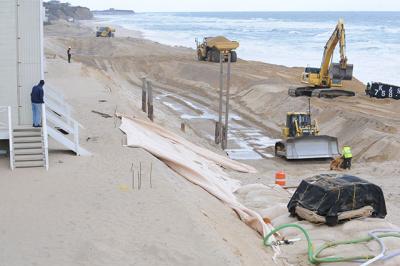Western Third of Montauk Project Complete

The first section of the Army Corps of Engineers’ sandbag “dune” on the downtown Montauk beach has been finished. It covers the western third of the project, the entirety of which extends from South Emery Street to near Surfside Place.
“The bags are in, the sand is in place, and it’s covered to the final elevation,” Town Supervisor Larry Cantwell said after a visit to the site on Tuesday with other board members.
Contractors hired and paid by the Army Corps dug a trench on the beach and placed sandbags filled with a slurry of water and quarried sand in the hole, piling them on top of one another.
While the final elevation of the sandbag pile is 15 feet above a point in the surf zone where mean sea level is measured, the finished pile of sandbags itself does not rise far above the beach surface.
They are topped with three feet of sand, with the top portion being sand taken from the Montauk beach rather than the coarse orange upland quarry sand.
“It pretty much runs above the existing dune line,” Mr. Cantwell said earlier this week. “When it’s finished the sandbags are actually buried in the existing beach.”
Wooden walkways will be placed over the piled bags for pedestrian access to the water. While tall pilings to support the walkways have been driven into the sand all along the downtown project area, those poles will be cut and shortened so that the walkways will be only a foot and a half above the beach, Kim Shaw, the town’s director of natural resources, said last week.
The sandbag wall is meant to prevent the ocean from licking away at and eroding the beach, Mr. Cantwell explained. “When we have a storm and we have erosion it cuts the beach; it undermines the beach,” Mr. Cantwell said. The Corps of Engineers premise is that the sandbags will hold where the beach sand would have been lost.
And, he said, “if you look at the way it is shaped,” rather than “a flat beach that runs right up to the natural dune line, now [an ocean surge] has got to climb 15 feet to get over the top.”
Though high tides and stormy conditions earlier this week caused a tidal rush onto the areas of beach still under construction, which was documented by Montauk residents carefully watching the project, the completed section “actually held up pretty well compared to the section that is under construction,” Mr. Cantwell said. At high tide “the water came up to the base” of the finished sandbag wall, he said.
Once the Army Corps is done, the town and county will have to shoulder the financial burden of keeping the sandbag pile covered with three feet of sand — a cost that opponents have said will far exceed estimates as storms continually remove the sand topping.
“This is short term at best,” Mr. Cantwell said on Tuesday. He and other board members have stressed the need to press the Army Corps to replenish the beach, adding sand to widen it, under its longer-range coastal plans for the area from Fire Island to Montauk Point.
Besides raising questions about negative effects of the sandbag wall, opponents have raised doubts about the potential for the Corps to actually undertake that larger project and whether the sandbags would be removed, as has been discussed, should that take place.
Once the sandbags are all in place, the beach area around the wall will be fenced off. “They’re trying to keep people, vehicles, and activity off the dune,” Mr. Cantwell said.
“The usable beach areas will definitely be less than it would have been . . . and that’s a problem, until we get a lot of sand in front of this,” he said.
Negotiations are taking place with the Army Corps, Mr. Cantwell said, about the contractor’s removal of a natural dune at the project’s western end. The sight of machines digging into that dune galvanized a wave of protest against the entire project, including work site protests last fall that resulted in a number of arrests.
The natural dune rose much higher than the artificial one made of the covered sandbags.
“We are asking the Corps that that dune be replaced to its original elevation,” Mr. Cantwell said. “They’re fixed on this 15-foot elevation,” he said. “I want that dune totally restored.”
